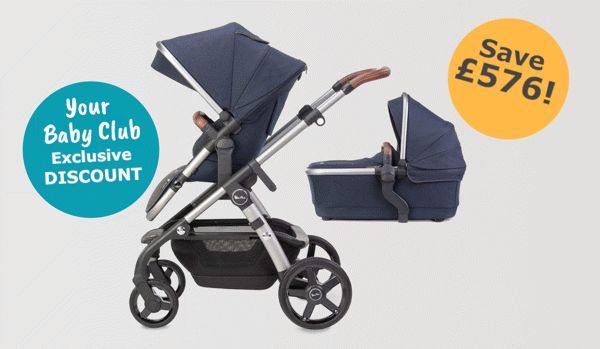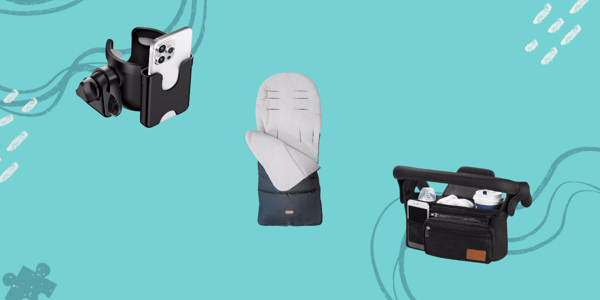Choosing the best pushchair for you and your baby is a huge decision. After everything for the nursery, it’s probably the most expensive purchase that you’ll make for your little one, so you want to make sure to get it right.
If you’ve just started your research on the best brands of pushchairs and prams out there, or the best prams for a newborn, one thing that might have seemed a little confusing is the sheer number of different names that there are out there for 4-wheeled things used to push a baby around. We get it, it can be a lot to take in! Here’s the key differences between each so it’s a little easier to work out what’s best for you.
Prams, Buggies, Pushchairs, Travel Systems: What’s the Difference?
- Pram- Prams are typically the main choice for newborns and younger babies, and an essential for most new parents. They let the baby lie flat, which is the best position for newborn babies to be in according to safe sleep guidance. Prams tend to be parent facing, coming with a bassinet/carrycot, and many of them can fold flat.
- Pushchair- As the name somewhat gives away, a pushchair is basically a chair on wheels for your baby. They’re made for older babies, usually older than six months, that can comfortably sit up on their own and don’t need to be laid flat in a pram anymore. Most pushchairs have settings that let the baby parent-face as well as outward face so they can take the big world around them in.
- Buggy- The definition of a buggy might vary depending on who you’re talking to. Lots of people use the term interchangeably with ‘pushchair’, but they are typically a bit lighter weight and travel friendly than a standard pushchair. Usually quite a bit cheaper than pushchairs, and easy to manoeuvre, but might not be quite as durable for full time use.
- Travel System- A travel system is basically a 2-in-1 pushchair that comes with a car seat, or a 3-in-1 pushchair with a car seat and a carry cot. Newborn travel systems are super popular options for new parents, both for the possible price savings and the functionality. If you’re looking for a pram with a car seat, all parts of a travel system will be interchangeable, meaning that you can switch between attachments depending on what you’re doing throughout the day.
When Should You Buy a Pushchair?
The only real answer to when you should buy a pushchair or pram, is whenever is right for you! If you’ve done all your research, found the pram that you want, and found an amazing deal while you’re 20 weeks- just buy it! The only real thing to consider is whether you have space to store it for the months before baby arrives. You might have heard the old wives tale that it’s bad luck to have the pushchair in the house before the baby is born, but realistically it’s not going to have the power to impact anything.
The main thing when buying your pushchair is that you don’t leave it too late. Like we mentioned, it is probably the biggest purchase you’ll make for your little one. Plus, if you’re looking at an all in one travel system, you’ll need to make sure you have it to bring your little one home from the hospital. Ideally, we’d recommend having it at home and ready from around 35 weeks, so you want to be ordering it around 33 weeks.
This gives you some leeway for delayed delivery of the pushchair, early delivery of your little one, and some time to play around and get used to how it works ahead of time! Trust us, neither of you want to be faffing around getting it out of the box as you get ready to leave the house for the first time with your baby. Get it set up and practice folding it away, putting it in the boot, and even changing the attachments. Anything to make your life easier during the newborn stage!
Do My Car Seat and Pram Need To Be From the Same Brand?
If you want to buy a particular pram or pushchair, but have noticed that the brand doesn’t actually offer a travel system or car seat to go with it, you’re probably wondering whether it’s worth buying. Or you’ve got your eye on a pushchair but the car seat that ticks all your boxes is from somewhere else, or the car seat that matches your pushchair isn’t compatible with your vehicle.
What lots of people don’t realise is that most of the big brands’ prams and pushchairs can now be used with car seats from other brands. That changes everything, we know! You might need to buy an adaptor to make the connection, but these aren’t expensive, and if you’ve found the car seat that’s right for you in every other way, it can definitely be worth it.
With most new prams and pushchairs being compatible with separate car seats, the need to find a travel system that meets all of your needs is less important than it has been in recent years. You now have way more flexibility and more options to find the perfect combination!
Things to Consider When Buying a Pushchair
So, you’ve seen all of the options out there and you’ve been left wondering how you could ever narrow it down to just one. Hey, we’ve been there! Before you look through our top picks of the best prams and lightweight pushchairs, there are a few questions you can ask yourself to help choose the one that’s best for you.
How Big is Your Boot?
This is one thing that we often hear our community members complain about. Imagine this, you’ve just got the dream family car that you’ve always wanted, only to find out six months later that there’s no way you’re fitting even a foldable pram in that boot. Or you’ve had your eye on the perfect pushchair for your little one, only to find out it doesn’t fit in your car. Disaster!
When talking boot space, car manufacturers tend to measure in terms of litres. For a foldable pram or pushchair to comfortably fit, you’ll be wanting to make sure your boot is around 380-400 litres in size. You probably don’t know the size of your boot in litres off the top of your head…but a quick google search of the make and model should let you know.
Another way to work out if it fits, is to find out the folded dimensions of your pram, which can usually be found on the manufacturer’s website, and then head to your car with a tape measure and check the internal dimensions, taking into account the wheel arches, parcel shelf and room for shopping!
What Accessories Would You Make Most Use Of?
Pushchair accessories are definitely one of the biggest selling points. The 3-in-1 travel systems offered by brands have quickly become nine and twelve-piece bundles with accessories you never even thought you needed! This is great, and can save you a lot of money compared to buying it all separately, but will you actually use all of the things they offer?
Head here for our top picks of the best pushchair accessories.
If you already have a pram bag and toys from your last baby or passed on from a friend, it might not be worth going for a bundle including these accessories when looking to compare pushchairs. Still, you might find the built-in foot-muffs to be a welcomed addition when you’re out with your little one on a crisp winter morning, or a rain cover included for our rainy British weather, or a cup holder invaluable for your coffee cup on your long strolls around the block to get baby to sleep.
Before browsing through our pick of the best pushchairs, take a look at the different accessory options that come in the bundles, and make a list of the ones you think will be of most use to you. This will let you look through our top picks with an idea of what you’re actually looking for, and what might not be worth it.
How Long Will It Be Until You’ll Be Buying Another?
With most prams and pushchairs coming with a pretty hefty price tag, you want to be thinking long term when you make your purchase. As we mentioned earlier, prams are the main choice for newborns and younger babies up to six months, while they still need to be lying flat.
If you buy a travel system that can be used as a stroller once your little one is sitting upright, make sure to think ahead about what you might want at that time. If you think that having the option for your baby to face you as well as a forward face, make sure to check that the one you go for has this option. The last thing you want is to be buying a whole new pushchair in six months time if you can avoid it.
What Is a Bassinet Attachment and Do I Need One for My Pram?
A bassinet attachment is a flat-laying bassinet, and is a safe place for your newborn to sleep. Many pushchair seats don’t recline all the way back to a flat position. This means that if your newborn was to lie back in one, their back would be slightly curved with their neck tilted forward.
Without neck strength, this isn’t a safe position for your baby to sleep in. This also goes for car seats too. Check out our picks of the best car seats. Because of this, it’s recommended that young babies are only in car seats or capsule seats for less than two hours at a time.
A bassinet is the perfect alternative where you can let your little one drift off without worrying and can be used indoors or out and about. So, if you’re shopping for your newborn, or your little one is still under six months old, you’ll want to look at a bassinet attachment to go with it.
Do I Need a Foldable Pushchair or Pram?
Making sure to get a compact, foldable pushchair that can easily fold to fit in the boot of a car or for travelling is often thought of as a must-have feature for new mums. Depending on where you live, how often you’ll be out and about in the car or public transport with your baby, how big your car is, and other lifestyle factors, a good foldable pushchair can be super important, particularly once they’re older than 6 months.
Most pram and pushchair frames are fully foldable, but there’s definitely a lot of variation in how they fold, how compact they get, how heavy they are, and how easy they are to fold. Top tip: try not to focus on how compact it can go as the deciding factor.
It might seem amazing that a pushchair can fold right down to a tiny size that can fit anywhere, and it can definitely help when out and about, but this can sometimes mean that the durability and sturdiness isn’t quite on par with the bigger, more robust models, especially if you’re after an all-terrain buggy.
Can You Use a Travel System for Toddlers?
Travel systems for newborns that include a car seat, or are compatible with particular car seats, normally all work with Group 0+ car seats. These seats can hold up to 13kg (though most car seats these days go by height rather than weight), and will last most babies until they’re 12-15 months old.
There are car seats out there that can last babies from a newborn until the age of four (Group 0+/1), but these stay fixed in the car and won’t work with a travel system for a newborn. This doesn’t mean that the travel system will be useless for you at this point, as you can definitely still use the pushchair seat component on the travel system, just not the car seat.
Head here for our favourite car seats.
Is My Pram Safe? How to Check the Safety Aspects
Pram, pushchair, and car seat safety is a HUGE topic, and one that all mums take seriously. There are strict British safety standards in place that govern all prams, strollers, pushchairs, and buggies When looking into a pram and whether it meets the required safety standards, look out for either a code starting with ‘BS’ followed by four numbers, or ‘BSEN’ followed by numbers including the year of the recognition on the label or online description.
Even if you know that the model you’re looking at meets safety standards, it’s always best to see a model of the pushchair in person and work through some of the different safety elements. Try to check the following safety aspects to know if a pram is the right choice for you:
- Brakes - Make sure that the brakes on the pushchair are easy to apply, and that the brakes are strong enough to properly bring the pushchair to a stop, even on an incline and with items in the storage section.
- Stability - When testing out the pushchair, make sure to test it out moving it around in different directions to check it won’t be tipping over easily. This is where bulkier, wide based prams tend to perform better.
- Safety harness - You’ll want to make sure that the pram or pushchair you go for has a five-point safety harness, rather than a three-point one. This will go over your baby’s shoulders, around their waist, and in between their legs, to make sure they’re properly secure.
- Wheels - Make sure that the wheels are securely fitted to the pushchair, that they’re easy to manoeuvre, and that they’re the right type of tyre for the terrain you’ll be using it for.
How Much Should I Spend on a Pushchair?
There’s lots to think about when deciding how much to spend on a pushchair and which pram to buy, and with prices ranging from £50 to way over £1500, it’s hard to know what is the best middle ground. A recent survey found that two in five parents spent between £100 and £300 on their pushchair, while 16% paid less than £100.
As with most things, pushing the boat out for the most expensive pushchair model could see you paying a premium for the brand name to some extent. Look through our top picks of the best prams, and the best lightweight pushchairs, and find the one that’s right for you.





